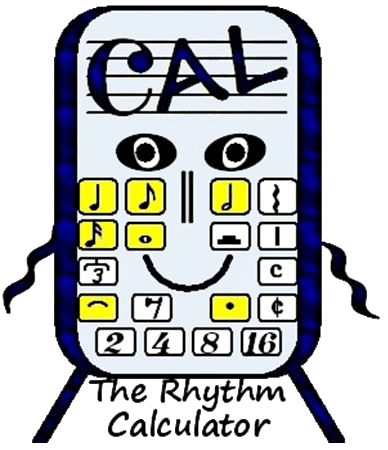
Welcome back! I am very appreciative that Scroll was “magically creative” while telling you the tale.
Scroll wanted to guide the class along further travels and continue the tale because there are more theories and additional contributors to the evolution of the music staff. As we all know, Scroll’s quest is to be quite thorough.
I told Scroll that we appreciate the offer, but everyone understands that dedicated and focused thought has created logical solutions to problems in music notation, exactly like practice. So – I made a deal with Scroll.
Scroll now is taking a short and well deserved vacation, flying around the world in the pursuit of timeless knowledge. Since Scroll is busy and I am on my way to the computer lab to prepare review charts, this is the perfect time for Cal to teach you all about rhythm notation. Cal, you have everyone’s focused attention.

Thanks, Q! — Perfect Timing is what I am all about and what I will teach you. Since you already know about keeping a steady tempo, it’s time for you to learn rhythm-notation symbols, their names, and what they all mean.
Acquiring rhythm and counting know-how, is the primary-step to becoming a skilled musician, one whom we can count on.
Rhythm Notation is a new topic for most of you. Once you learn the symbols and what they mean, you will see that rhythm notation is very logical. Since I am a Rhythm Calculator, I will teach you the knowledge of how to calculate rhythm.
In my picture, did you notice that some of my note buttons are illuminated?
These buttons activate the proper note-code that unlocks a new Quest level. Rhythm Notation is the written code that musicians read in order to perform sounds of varied time within a tempo.
Rhythm is music’s most important layer!
It is now time to explore the code of Rhythm Notation, in the:

Meet Cal Universal Language Rhythm Notation Music Staff Origins of the Staff
Rhythm Laboratory Notation Parts Note Heads Stems Beams Flags Note Construction
Common-Time Measures Bar-Lines Counting in Common-Time Whole, Half and Quarter Notes
Ties Dots Time-Signatures Q’s Rhythm Review Time-Signature Rules Beat Accent
Down-Beat and Up-Beat Conducting Patterns Cut-Time Common-Time Beat Emphasis
Three-Beat Measures Note Values Rhythm Workouts The ‘Cycle’ Note Equivalents
Counting Sub-Divisions “If You Can Say It, You Can Play It” Author’s Story Sub-Division Lingo
Quarter Notes with Eight Notes Adding Sixteenth Notes Notes Sharing Beams Beam Awareness Pointers
Triplets Triplet Workout Compound-Time Compound-Time Workout Music Rests
Rest and Note Equivalents Whole Rest Half Rest Quarter Rest Eighth Rest Sixteenth Rest
Dotted Rests Q’s Rest Review Process of Sub-Division Relating Rests to Notes Rhythm Exam Prep
Level 1 Rhythm Exam Level 2 Rhythm Exam Level 3 Rhythm Exam
Rhythm Laboratory Notation Parts Note Heads Stems Beams Flags Note Construction
Common-Time Measures Bar-Lines Counting in Common-Time Whole, Half and Quarter Notes
Ties Dots Time-Signatures Q’s Rhythm Review Time-Signature Rules Beat Accent
Down-Beat and Up-Beat Conducting Patterns Cut-Time Common-Time Beat Emphasis
Three-Beat Measures Note Values Rhythm Workouts The ‘Cycle’ Note Equivalents
Counting Sub-Divisions “If You Can Say It, You Can Play It” Author’s Story Sub-Division Lingo
Quarter Notes with Eight Notes Adding Sixteenth Notes Notes Sharing Beams Beam Awareness Pointers
Triplets Triplet Workout Compound-Time Compound-Time Workout Music Rests
Rest and Note Equivalents Whole Rest Half Rest Quarter Rest Eighth Rest Sixteenth Rest
Dotted Rests Q’s Rest Review Process of Sub-Division Relating Rests to Notes Rhythm Exam Prep
Level 1 Rhythm Exam Level 2 Rhythm Exam Level 3 Rhythm Exam




